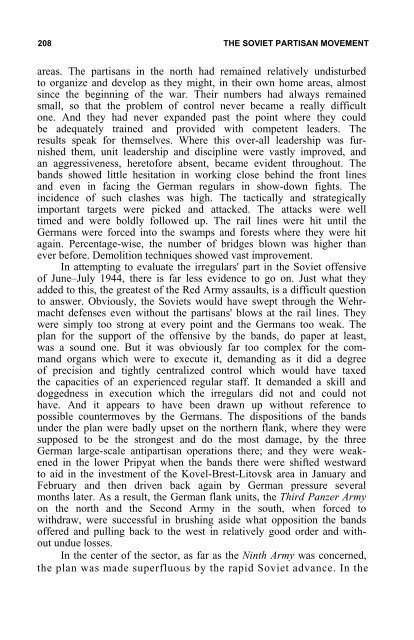the soviet partisan movement 1941-1944 by edgar m. howell
the soviet partisan movement 1941-1944 by edgar m. howell
the soviet partisan movement 1941-1944 by edgar m. howell
Create successful ePaper yourself
Turn your PDF publications into a flip-book with our unique Google optimized e-Paper software.
208 THE SOVIET PARTISAN MOVEMENT<br />
areas. The <strong>partisan</strong>s in <strong>the</strong> north had remained relatively undisturbed<br />
to organize and develop as <strong>the</strong>y might, in <strong>the</strong>ir own home areas, almost<br />
since <strong>the</strong> beginning of <strong>the</strong> war. Their numbers had always remained<br />
small, so that <strong>the</strong> problem of control never became a really difficult<br />
one. And <strong>the</strong>y had never expanded past <strong>the</strong> point where <strong>the</strong>y could<br />
be adequately trained and provided with competent leaders. The<br />
results speak for <strong>the</strong>mselves. Where this over-all leadership was furnished<br />
<strong>the</strong>m, unit leadership and discipline were vastly improved, and<br />
an aggressiveness, heretofore absent, became evident throughout. The<br />
bands showed little hesitation in working close behind <strong>the</strong> front lines<br />
and even in facing <strong>the</strong> German regulars in show-down fights. The<br />
incidence of such clashes was high. The tactically and strategically<br />
important targets were picked and attacked. The attacks were well<br />
timed and were boldly followed up. The rail lines were hit until <strong>the</strong><br />
Germans were forced into <strong>the</strong> swamps and forests where <strong>the</strong>y were hit<br />
again. Percentage-wise, <strong>the</strong> number of bridges blown was higher than<br />
ever before. Demolition techniques showed vast improvement.<br />
In attempting to evaluate <strong>the</strong> irregulars' part in <strong>the</strong> Soviet offensive<br />
of June–July <strong>1944</strong>, <strong>the</strong>re is far less evidence to go on. Just what <strong>the</strong>y<br />
added to this, <strong>the</strong> greatest of <strong>the</strong> Red Army assaults, is a difficult question<br />
to answer. Obviously, <strong>the</strong> Soviets would have swept through <strong>the</strong> Wehrmacht<br />
defenses even without <strong>the</strong> <strong>partisan</strong>s' blows at <strong>the</strong> rail lines. They<br />
were simply too strong at every point and <strong>the</strong> Germans too weak. The<br />
plan for <strong>the</strong> support of <strong>the</strong> offensive <strong>by</strong> <strong>the</strong> bands, do paper at least,<br />
was a sound one. But it was obviously far too complex for <strong>the</strong> command<br />
organs which were to execute it, demanding as it did a degree<br />
of precision and tightly centralized control which would have taxed<br />
<strong>the</strong> capacities of an experienced regular staff. It demanded a skill and<br />
doggedness in execution which <strong>the</strong> irregulars did not and could not<br />
have. And it appears to have been drawn up without reference to<br />
possible countermoves <strong>by</strong> <strong>the</strong> Germans. The dispositions of <strong>the</strong> bands<br />
under <strong>the</strong> plan were badly upset on <strong>the</strong> nor<strong>the</strong>rn flank, where <strong>the</strong>y were<br />
supposed to be <strong>the</strong> strongest and do <strong>the</strong> most damage, <strong>by</strong> <strong>the</strong> three<br />
German large-scale anti<strong>partisan</strong> operations <strong>the</strong>re; and <strong>the</strong>y were weakened<br />
in <strong>the</strong> lower Pripyat when <strong>the</strong> bands <strong>the</strong>re were shifted westward<br />
to aid in <strong>the</strong> investment of <strong>the</strong> Kovel-Brest-Litovsk area in January and<br />
February and <strong>the</strong>n driven back again <strong>by</strong> German pressure several<br />
months later. As a result, <strong>the</strong> German flank units, <strong>the</strong> Third Panzer Army<br />
on <strong>the</strong> north and <strong>the</strong> Second Army in <strong>the</strong> south, when forced to<br />
withdraw, were successful in brushing aside what opposition <strong>the</strong> bands<br />
offered and pulling back to <strong>the</strong> west in relatively good order and without<br />
undue losses.<br />
In <strong>the</strong> center of <strong>the</strong> sector, as far as <strong>the</strong> Ninth Army was concerned,<br />
<strong>the</strong> plan was made superfluous <strong>by</strong> <strong>the</strong> rapid Soviet advance. In <strong>the</strong>
















